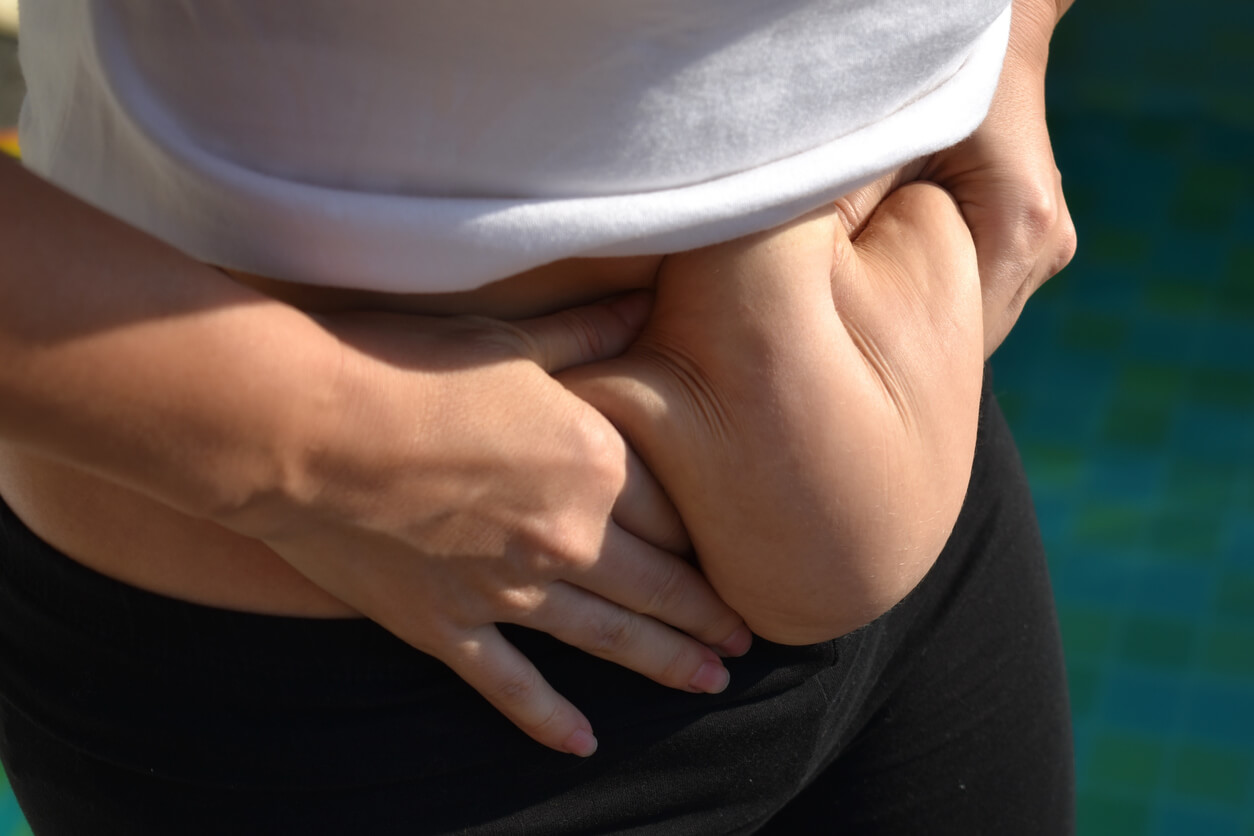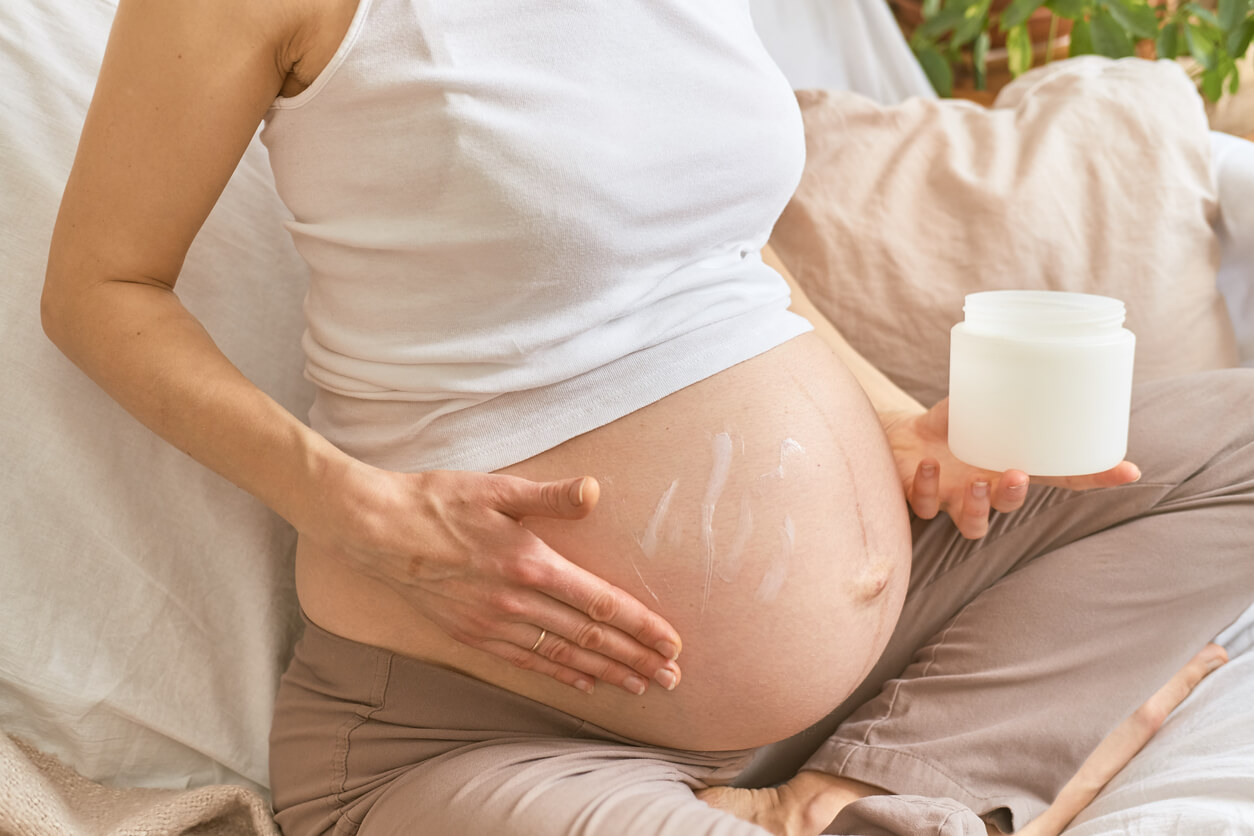Postpartum Skin Changes and How to Treat Them

Skin changes not only occur during pregnancy but also in the postpartum period. In fact, they’re the result of the adaptation of your body to the unborn baby. While some of these physical changes can be bothersome, there are several therapeutic options to mitigate and treat postpartum skin changes. Are you interested in discovering them? In the following article, we’ll tell you more.
Postpartum skin changes in women
After the birth of your little one, it’s essential to continue with the care of your body. You can’t lose sight of the fact that it’s just contributed to the incredible genesis of a new life.
According to a publication in The Journal of Family Medicine and Primary Care, more than 90% of pregnant women show significant changes in their skin. For this reason, we’re going to share with you the most frequent postpartum skin changes so that you can verify that what happens to you is completely normal.
1. Skin flaccidity

Most of the skin changes that pregnant women experience disappear after childbirth, at different speeds. However, skin flaccidity is one of the changes that tends to persist over time.
This happens because the skin is made up of elastin and collagen. Both fibers expand a lot during pregnancy and can break if they expand to an extreme. Also, once distended, they may not return to their original state.
Experts believe that collagen can be stretched up to 10 times without damaging the fibers that make it up.
It’s essential that we clarify that although there are treatments to recover skin elasticity and muscle tone, both processes can take time. Keep in mind that sagging skin is one of the postpartum skin changes that’s most difficult to combat.
Some of the therapeutic options that can help you combat skin flaccidity include the following:
- Perform an aerobic exercise routine to tone muscles and burn fat. For example, swimming, brisk walking, bicycling, or jogging. Always consult with your doctor before taking up any activity.
- Maintain a good state of hydration. Water helps hydrate the skin and promotes its elasticity.
- Get massages with oils. Some essential oils can contribute to skin repair.
- Eat healthy fats and proteins. Proteins provide the collagen necessary for muscle development. However, the needs of this nutrient are individual and vary according to the physical activity that you practiced as well as your weight and height.
- Practice strength exercises to shape and tone your muscles.
2. Dry skin
After childbirth, one of the most noticeable changes in your skin is its lack of hydration, which is reflected in the lack of luminosity and vitality.
Therefore, the moisturizing of your skin must be sufficient, both inside and out.
The consumption of liquids is essential, even more so when you breastfeed. You should drink at least 2 liters of water a day. Healthy eating also helps combat dry skin, and in fact, foods with antioxidants, minerals, and vitamins can promote collagen production.
To hydrate and moisturize the skin from the outside, the use of essential plant oils or creams that provide firmness and help restore tissues is recommended. Some examples of them are the following:
- Argan oils
- Sweet almond oil
- Creams with hyaluronic acid
- Emulsions with a high content of vitamin A, vitamin E or urea
3. Melasma on the face, one of the most common postpartum skin changes
During pregnancy, symmetric hyperpigmentation spots can develop on the face, which are known as gestational melasma. These adopt a brown hue and are located on the cheekbones, forehead, or upper lip.
In most cases, these spots tend to disappear or fade on their own. However, your doctor may also prescribe depigmenting products, such as hydroquinone, or gentle exfoliation procedures with delicate cosmetics.
Finally, it’s advisable to use sunscreen with a filter greater than 50 every day and repeat its application every two hours if you’re exposed to sunlight.
4. Stretch marks

Stretch marks are something that bothers a lot of women (and men), not just those who were pregnant. They consist of linear marks that form on the skin surface as a result of the rupture of collagen fibers due to great distension.
What’s more, the causes that predispose individuals to their appearance are hormonal changes and poor skin hydration.
It’s best to start treatment to combat them when they still have a pink coloration, as this is the initial stage of their development. Otherwise, they turn white, and this indicates that the fibrous tissue has consolidated. After that point, the effective therapeutic options are more invasive.
Depending on the type of stretch mark that’s present, management may include some of the following options:
- Red stretch marks: Products with rosehip, vitamin K, A, or E are indicated, which contribute to the production of collagen to repair the affected skin. One of the fundamental pillars of the treatment is the constancy of their application several times a day.
- White Stretch Marks: This second type requires the use of laser, microneedling, microabrasion, or collagen induction therapy.
Prevention is the best therapeutic option
The most important thing to take care of the skin during and after pregnancy is to maintain a constant and adequate care routine for your body and face. These habits include moisturizing the skin, a healthy diet, and the daily and constant use of sun protection.
Skin changes not only occur during pregnancy but also in the postpartum period. In fact, they’re the result of the adaptation of your body to the unborn baby. While some of these physical changes can be bothersome, there are several therapeutic options to mitigate and treat postpartum skin changes. Are you interested in discovering them? In the following article, we’ll tell you more.
Postpartum skin changes in women
After the birth of your little one, it’s essential to continue with the care of your body. You can’t lose sight of the fact that it’s just contributed to the incredible genesis of a new life.
According to a publication in The Journal of Family Medicine and Primary Care, more than 90% of pregnant women show significant changes in their skin. For this reason, we’re going to share with you the most frequent postpartum skin changes so that you can verify that what happens to you is completely normal.
1. Skin flaccidity

Most of the skin changes that pregnant women experience disappear after childbirth, at different speeds. However, skin flaccidity is one of the changes that tends to persist over time.
This happens because the skin is made up of elastin and collagen. Both fibers expand a lot during pregnancy and can break if they expand to an extreme. Also, once distended, they may not return to their original state.
Experts believe that collagen can be stretched up to 10 times without damaging the fibers that make it up.
It’s essential that we clarify that although there are treatments to recover skin elasticity and muscle tone, both processes can take time. Keep in mind that sagging skin is one of the postpartum skin changes that’s most difficult to combat.
Some of the therapeutic options that can help you combat skin flaccidity include the following:
- Perform an aerobic exercise routine to tone muscles and burn fat. For example, swimming, brisk walking, bicycling, or jogging. Always consult with your doctor before taking up any activity.
- Maintain a good state of hydration. Water helps hydrate the skin and promotes its elasticity.
- Get massages with oils. Some essential oils can contribute to skin repair.
- Eat healthy fats and proteins. Proteins provide the collagen necessary for muscle development. However, the needs of this nutrient are individual and vary according to the physical activity that you practiced as well as your weight and height.
- Practice strength exercises to shape and tone your muscles.
2. Dry skin
After childbirth, one of the most noticeable changes in your skin is its lack of hydration, which is reflected in the lack of luminosity and vitality.
Therefore, the moisturizing of your skin must be sufficient, both inside and out.
The consumption of liquids is essential, even more so when you breastfeed. You should drink at least 2 liters of water a day. Healthy eating also helps combat dry skin, and in fact, foods with antioxidants, minerals, and vitamins can promote collagen production.
To hydrate and moisturize the skin from the outside, the use of essential plant oils or creams that provide firmness and help restore tissues is recommended. Some examples of them are the following:
- Argan oils
- Sweet almond oil
- Creams with hyaluronic acid
- Emulsions with a high content of vitamin A, vitamin E or urea
3. Melasma on the face, one of the most common postpartum skin changes
During pregnancy, symmetric hyperpigmentation spots can develop on the face, which are known as gestational melasma. These adopt a brown hue and are located on the cheekbones, forehead, or upper lip.
In most cases, these spots tend to disappear or fade on their own. However, your doctor may also prescribe depigmenting products, such as hydroquinone, or gentle exfoliation procedures with delicate cosmetics.
Finally, it’s advisable to use sunscreen with a filter greater than 50 every day and repeat its application every two hours if you’re exposed to sunlight.
4. Stretch marks

Stretch marks are something that bothers a lot of women (and men), not just those who were pregnant. They consist of linear marks that form on the skin surface as a result of the rupture of collagen fibers due to great distension.
What’s more, the causes that predispose individuals to their appearance are hormonal changes and poor skin hydration.
It’s best to start treatment to combat them when they still have a pink coloration, as this is the initial stage of their development. Otherwise, they turn white, and this indicates that the fibrous tissue has consolidated. After that point, the effective therapeutic options are more invasive.
Depending on the type of stretch mark that’s present, management may include some of the following options:
- Red stretch marks: Products with rosehip, vitamin K, A, or E are indicated, which contribute to the production of collagen to repair the affected skin. One of the fundamental pillars of the treatment is the constancy of their application several times a day.
- White Stretch Marks: This second type requires the use of laser, microneedling, microabrasion, or collagen induction therapy.
Prevention is the best therapeutic option
The most important thing to take care of the skin during and after pregnancy is to maintain a constant and adequate care routine for your body and face. These habits include moisturizing the skin, a healthy diet, and the daily and constant use of sun protection.
All cited sources were thoroughly reviewed by our team to ensure their quality, reliability, currency, and validity. The bibliography of this article was considered reliable and of academic or scientific accuracy.
- Ciechanowicz P, Sikora M, Taradaj K, Ruta A, Rakowska A, Kociszewska-Najman B, Wielgoś M, Rudnicka L. Skin changes during pregnancy. Is that an important issue for pregnant women? Ginekol Pol. 2018;89(8):449-52. doi: 10.5603/GP.a2018.0077. PMID: 30215465.
- Vora, R. V., Gupta, R., Mehta, M. J., Chaudhari, A. H., Pilani, A. P., & Patel, N. (2014). Pregnancy and skin. Journal of family medicine and primary care, 3(4), 318–324. https://doi.org/10.4103/2249-4863.148099
- Palma L, Tavares Marques L, Bujan J, Monteiro Rodrigues L. El agua dietética afecta la hidratación y la biomecánica de la piel humana. Clin Cosmet Investig Dermatol . 2015;8:413-421
This text is provided for informational purposes only and does not replace consultation with a professional. If in doubt, consult your specialist.








